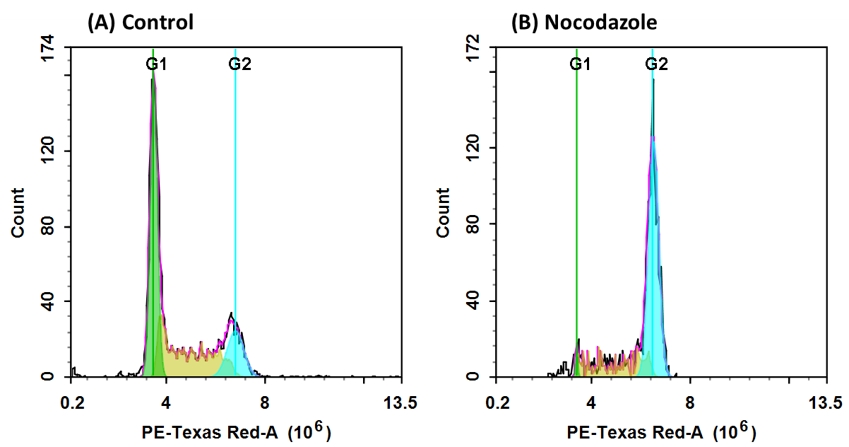Cell Meter 荧光法固定细胞周期检测试剂盒 红色荧光 适合于流式细胞检测
| Ex (nm) | 537 | Em (nm) | 618 |
| 分子量 | - | 溶剂 | - |
| 存储条件 | - |
产品货期
咨询
适用范围
用于固定细胞周期检测
产品介绍
Cell Meter™检测试剂盒是用于监测细胞活力和增殖状态的工具。细胞活力和增殖的监测可通过多种参数指标实现。在正常细胞中,DNA 密度会根据细胞所处的状态(生长、分裂、静止或执行常规功能)发生变化。细胞周期的进程由多种调控因子通过复杂相互作用共同控制。这些调控因子可激活转录因子,使其与DNA结合并启动或抑制蛋白质的合成,最终引导细胞分裂。这一调控级联中的任何异常都会导致细胞异常增殖,进而引发肿瘤形成等多种病理状态。
活细胞研究的潜在应用包括:测定细胞 DNA 含量和细胞周期分布以检测生长模式的变化、监测细胞凋亡,以及评估肿瘤细胞行为和抑癌基因机制。
Cell Meter 荧光法固定细胞周期检测试剂盒 采用Nuclear Red™ CCS1在固定细胞中监测细胞周期进程和增殖情况。该染料可穿过透化的细胞膜,并嵌入细胞 DNA 中。在试剂盒提供的 RNA 酶降解 RNA 后,Nuclear Red™ CCS1的信号强度与DNA含量呈直接正比。通过流式细胞仪(FL2通道)可准确测定样本中处于G0/G1期、S期、G2/M期以及凋亡前处于亚 G1 期的细胞比例。
适用仪器
| 流式细胞仪 | |
| Ex: | 488 nm |
| Em: | 610/20 nm |
| 通道: | PE-Texas Red 通道 |
样品实验方案
简要概述
1.用5×105至1×106cell/ mL的密度制备含测试化合物的细胞
2.用70%乙醇固定细胞
3.将0.5 µL 100X Nuclear Red CCS1和5 µL RNase A加入0.5 mL细胞溶液中
4.在室温下孵育30-60分钟
5.使用带有FL2通道的流式细胞仪分析细胞
实验步骤
1.用测试化合物处理细胞至预期时间(诱导凋亡或调控细胞周期)
2.对于每个样品,用0.5 mL PBS制备细胞,密度为5×105至1×106细胞/ mL。
贴壁细胞:将细胞用胰蛋白酶消化后悬浮于含10% FBS培养基,1000 rpm离心5分钟),PBS重悬细胞
悬浮细胞:将细胞1000 rpm离心5分钟,PBS重悬细胞。
注意:不同细胞系需单独评估最合适处理密度
3.用70%乙醇固定细胞:
将0.5 mL细胞悬液加入1.2 mL无水乙醇(终浓度约70%)
在冰上孵育细胞至少2小时(或在-20°C过夜)。在染色之前,细胞可以在-20°C下保存2年。
注意:乙醇固定适用于细胞表面抗原检测;甲醇固定适用于细胞内抗原检测;全细胞分析需加入RNase消除双链RNA干扰;在酒精固定之前,检测某些胞内抗原时建议先用PBS中的1%多聚甲醛预固定(4-6°C,10分钟),将有助于将蛋白质保留在细胞中
4.用Nuclear Red CCS1染色细胞:
4.1 1000 rpm离心细胞5分钟,用冷PBS至少洗涤一次。
4.2 用0.5 mL Assay buffer(组分C)重悬细胞
4.3 5 µL 100X Nuclear Red CCS1(组分A)和5 µL 100X RNase A(组分B)。
4.4.室温避光孵育细胞30至60分钟。
注意:孵育时间需根据细胞类型和浓度优化
5.可选:1000 rpm离心5分钟后用Assay buffer重悬
6.使用FL2通道(Ex / Em = 490/620 nm),通过流式细胞仪检测荧光强度。






